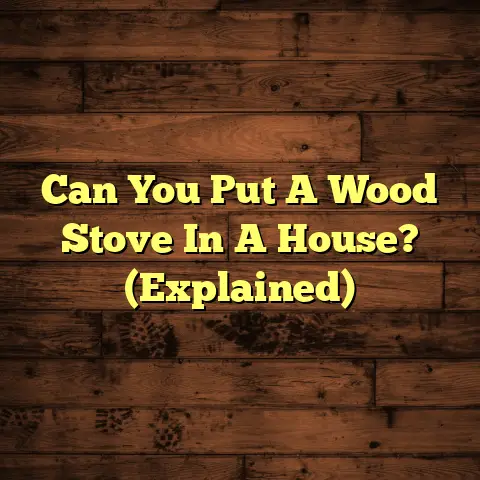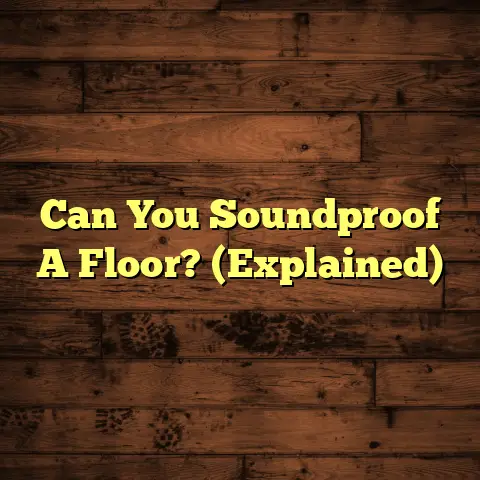Wood Floor Refinishing: Cost Revealed! (4 Prices)
Let’s talk about wood floors.
Specifically, that nagging thought:
“Is refinishing my wood floors really worth the cost?”
I hear you.
There’s a common myth floating around that refinishing wood floors is just too darn expensive.
That it’s not worth the investment.
Well, as a flooring contractor with years of experience under my belt, I’m here to tell you: that’s simply not true!
Think of it this way:
A beautifully refinished wood floor can dramatically increase your home’s resale value.
We’re talking a potential return on investment (ROI) of 70-80%! (According to the National Association of Realtors).
Plus, it just looks fantastic!
It breathes new life into your space, making it feel fresh and inviting.
And let’s not forget the durability factor.
A properly refinished floor can last for decades, saving you money on replacements down the line.
Now, I’m not going to sugarcoat it:
Refinishing does come with a price tag.
But understanding the costs involved is key to making an informed decision.
So, stick with me, and we’ll break down everything you need to know.
Section 1: Understanding Wood Floor Refinishing
Okay, so what exactly does “refinishing” entail?
Basically, it’s a process of restoring your wood floors to their former glory.
It typically involves these steps:
- Sanding: Removing the old finish, scratches, and imperfections.
- Staining (optional): Applying a new color to the wood.
- Sealing: Protecting the wood with a durable topcoat.
Now, not all wood floors are created equal.
The type of wood you have will determine if refinishing is even an option.
Solid Hardwood: This is the real deal.
Solid wood floors can be sanded and refinished multiple times, making them a great long-term investment.
Engineered Wood: This type of flooring has a thin layer of real wood on top of a plywood or composite core.
You can usually refinish engineered wood, but only if the top layer is thick enough.
(Typically, you’ll want at least 2-3mm of wear layer to work with).
If it’s too thin, sanding could damage the floor.
Ultimately, refinishing is all about bringing back the beauty of your floors.
It extends their lifespan, improves your home’s value, and just makes your space feel more welcoming.
What’s not to love?
Section 2: Factors Influencing Refinishing Costs
Alright, let’s get down to brass tacks.
What factors actually impact the cost of refinishing your wood floors?
There are four main culprits:
1. Type of Wood
Believe it or not, the type of wood you have can significantly affect the price.
Some species are simply more expensive to work with than others.
For example:
- Oak: A classic and readily available choice, making it relatively affordable to refinish.
- Maple: Harder than oak, which can make sanding a bit more challenging (and thus, slightly more expensive).
- Cherry: A beautiful but softer wood, requiring a more delicate touch during the refinishing process.
- Exotic Woods (Brazilian Cherry, Ipe, etc.): These can be very dense and require specialized equipment and expertise, driving up the cost.
The hardness of the wood also plays a role.
Harder woods are more durable and resistant to scratches and dents, but they can be more difficult (and time-consuming) to sand.
This translates to higher labor costs.
You can use the Janka hardness scale to get an idea of how resistant different wood species are to dents and wear:
| Wood Species | Janka Hardness |
|---|---|
| Brazilian Walnut | 3680 |
| Hickory | 1820 |
| Hard Maple | 1450 |
| Red Oak | 1290 |
| White Oak | 1360 |
| American Cherry | 950 |
| American Walnut | 1010 |
| Yellow Pine | 690 |
| Douglas Fir | 660 |
| Eastern White Pine | 380 |
2. Condition of the Floor
This is a big one.
If your floors are in rough shape, with deep scratches, dents, or water damage, it’s going to take more time and effort to restore them.
Extensive repairs, such as replacing damaged boards, can significantly increase the cost.
Let’s say you have some boards that are warped or rotting due to water damage.
Those will need to be replaced before any refinishing can take place.
That adds to the material costs and the labor time.
3. Size of the Area
This one’s pretty straightforward.
The larger the area you’re refinishing, the more it’s going to cost.
More square footage means more materials, more labor, and more time.
To get a rough estimate, measure the length and width of each room you want to refinish and multiply those numbers together.
Then, add up the square footage of all the rooms.
For example:
- Living Room: 15 feet x 20 feet = 300 sq ft
- Dining Room: 12 feet x 15 feet = 180 sq ft
- Hallway: 3 feet x 10 feet = 30 sq ft
- Total: 300 + 180 + 30 = 510 sq ft
Keep in mind that this is just an estimate.
A professional contractor will be able to give you a more accurate quote after assessing the space.
4. Geographic Location
Labor costs can vary dramatically from one region to another.
In urban areas with a higher cost of living, you can expect to pay more for refinishing services than in rural areas.
For example, a contractor in New York City is likely to charge more per hour than a contractor in a small town in Kansas.
Demand also plays a role.
If there’s a high demand for flooring contractors in your area, prices may be higher due to increased competition.
Section 3: Breaking Down the Costs
Okay, now for the moment you’ve all been waiting for:
Let’s break down the actual costs of wood floor refinishing.
I’m going to give you four different price categories, ranging from DIY to high-end.
1. DIY Refinishing
What it entails: Renting equipment, buying materials, and doing all the work yourself.
Pros: The cheapest option (in terms of upfront costs).
Cons: Time-consuming, physically demanding, and requires a certain level of skill and experience.
Costs:
- Sander Rental: \$50-\$100 per day
- Edger Rental: \$20-\$40 per day
- Sandpaper: \$50-\$100
- Stain (optional): \$30-\$50 per gallon
- Polyurethane: \$40-\$60 per gallon
- Applicators, Brushes, etc.: \$20-\$40
- Safety Gear (mask, gloves, etc.): \$20-\$30
Total Estimated Cost: \$230 – \$420 for a small room (around 200 sq ft).
Important Considerations:
- DIY refinishing can be a great way to save money, but it’s not for everyone.
- If you’re not comfortable using power tools or you don’t have experience with woodworking, it’s best to leave it to the professionals.
- Mistakes can be costly and time-consuming to fix.
- Proper safety precautions are essential.
2. Basic Professional Refinishing
What it entails: Hiring a professional contractor to sand, stain (optional), and seal your floors.
Pros: Faster, less physically demanding, and ensures a professional finish.
Cons: More expensive than DIY.
Costs: \$3-\$5 per square foot.
What’s Included:
- Sanding the existing finish
- Applying one coat of stain (optional)
- Applying two coats of polyurethane
- Light cleanup
Total Estimated Cost: \$600 – \$1,000 for a 200 sq ft room.
Important Considerations:
- Get multiple quotes from different contractors.
- Check their references and read online reviews.
- Make sure they are licensed and insured.
- Ask about their experience with your type of wood.
3. Mid-Range Refinishing
What it entails: Includes additional services such as custom stain colors, upgraded finishes, and minor repairs.
Pros: Allows for more customization and can address minor imperfections in the floor.
Cons: More expensive than basic refinishing.
Costs: \$5-\$8 per square foot.
What’s Included:
- Everything in basic refinishing, plus:
- Custom stain color matching
- Application of three coats of polyurethane
- Minor repairs (filling small cracks and holes)
Total Estimated Cost: \$1,000 – \$1,600 for a 200 sq ft room.
Important Considerations:
- This is a good option if you want a specific look or if your floors have some minor damage that needs to be addressed.
- Discuss your options with the contractor and get their recommendations.
4. High-End Refinishing
What it entails: Luxury services such as specialized finishes (e.g., oil-based finishes), intricate detailing (e.g., borders, inlays), and high-end materials.
Pros: Creates a truly unique and stunning floor.
Cons: The most expensive option.
Costs: \$8+ per square foot (can easily exceed \$15 per square foot for very complex projects).
What’s Included:
- Everything in mid-range refinishing, plus:
- Specialized finishes (e.g., oil-based, European hardwax oil)
- Intricate detailing (e.g., borders, inlays, medallions)
- Use of high-end materials (e.g., premium stains, imported wood)
- Extensive repairs and board replacement
Total Estimated Cost: \$1,600+ for a 200 sq ft room (can be much higher depending on the complexity of the project).
Important Considerations:
- This is for homeowners who want the absolute best and are willing to pay a premium for it.
- Choose a contractor with extensive experience in high-end refinishing.
- Be prepared to discuss your vision in detail and work closely with the contractor to achieve the desired result.
Section 4: Real-Life Examples and Case Studies
To give you a better sense of what to expect, let’s take a look at some real-life examples.
Case Study 1: The DIYer
- Homeowner: Sarah, a homeowner in suburban Chicago.
- Project: Refinishing the hardwood floors in her 150 sq ft bedroom.
- Approach: DIY
- Costs:
- Sander Rental: \$75
- Sandpaper: \$60
- Stain: \$40
- Polyurethane: \$50
- Applicators: \$25
- Total: \$250
-
Outcome: Sarah was able to save money by doing the work herself.
However, it took her an entire weekend, and she admits that the finish isn’t quite as smooth as it would have been if a professional had done it.
Case Study 2: The Budget-Conscious Homeowner
- Homeowner: John, a homeowner in rural Pennsylvania.
- Project: Refinishing the hardwood floors in his 400 sq ft living room.
- Approach: Basic Professional Refinishing
- Costs: \$3.50 per sq ft = \$1,400
-
Outcome: John hired a local contractor who offered a competitive price.
He was happy with the results and felt that it was a worthwhile investment.
Case Study 3: The Customization Enthusiast
- Homeowner: Maria, a homeowner in San Francisco.
- Project: Refinishing the hardwood floors in her 300 sq ft dining room.
- Approach: Mid-Range Refinishing
- Costs: \$6 per sq ft = \$1,800
-
Outcome: Maria wanted a specific stain color to match her furniture.
She hired a contractor who was able to create a custom stain blend that perfectly matched her vision.
She also opted for an upgraded finish that is more durable and resistant to scratches.
Case Study 4: The Luxury Seeker
- Homeowner: David, a homeowner in Beverly Hills.
- Project: Refinishing the hardwood floors in his 500 sq ft master bedroom.
- Approach: High-End Refinishing
- Costs: \$12 per sq ft = \$6,000
-
Outcome: David wanted a truly unique and luxurious floor.
He chose a rare imported wood and had the contractor install an intricate border around the perimeter of the room.
He also opted for an oil-based finish that enhances the natural beauty of the wood.
These are just a few examples, but they illustrate the wide range of costs and options available for wood floor refinishing.
Section 5: Conclusion
So, is wood floor refinishing worth the cost?
In my professional opinion, the answer is a resounding YES!
While it’s true that it can be a significant investment, the benefits far outweigh the costs.
Refinishing your wood floors can:
- Increase your home’s value
- Enhance its aesthetic appeal
- Extend the lifespan of your floors
- Create a healthier and more comfortable living environment
Ultimately, the decision of whether or not to refinish your wood floors is a personal one.
Weigh your options carefully, consider your specific circumstances, and choose the approach that best fits your needs and budget.
And remember, a well-maintained wood floor is a timeless investment that will bring beauty and value to your home for years to come.





